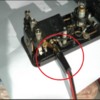Hello all.
I have finally gotten my layout up and running, but there seems to be a problem. Previously I have only operated one train or accessory at a time for test purposes, but before today, not all at once. I have two unconnected loops of tubular powered by the A and B terminals of the KW, with U being the common. Each loop is fed through their own independent bus bars, with power drops every so often. I also use a 1033 transformer to provide fixed 16 and 11 volts through it’s A and B terminals, with C being the common in this configuration. Turnouts, lights, and accessories are powered through their own independent 16 & 11 volt bus bars. I have ground straps running through all bust bars, effectively connecting all of the commons of both transformers.
This morning I was running everything, and after about five minutes the KW started emitting a very faint white smoke and an odor reminiscent of wet beef jerky. Not a burning plastic, or rubber smell. It never got hot, or changed its vibration characteristics. It was purchased freshly overhauled, and I thought it may just be lubrication burning off. On a hunch, I unplugged the 1033, and ran two trains at a scale highball for about a half hour. No smoke, no odor. Hmmmm... plugged the 1033 back in, and after a few minutes the odor returned. I stopped before any smoke started.
My turnouts are powered by fixed 16V through a bootstrap. They’re TinMan overhauled units, and if I’m not mistaken, provide additional center rail voltage, unlike the original Lionel fixed voltage plugs do. I believe this is my problem. I do see a small spark when a train goes through a turnout, and also when crossing insulated track sections that power 16V accessories. No spark when the 1033 was unplugged...
I guess I now realize the need to phase the transformers together, where I previously thought of them as electrically “unconnected.” Is this the case? If so, would I use the KW’s U terminals to the 1033’s C terminals since they are the commons? Obviously it’d be the variable A and/or B for testing the hot on the KW, but which hot should I use on the 1033, since I’m using only it’s fixed voltage posts. Would it be easier just to disconnect the transformer’s posts that feed the bus bars, and test/phase the transformers in the traditional way that’s been so well documented?
Any and all thoughts or ideas greatly appreciated ...
Tom






